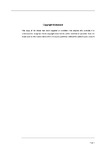Data Communication Signals of Opportunity for Navigation
| dc.contributor.supervisor | Ghita, Bogdan | |
| dc.contributor.author | Mansfield, Thomas Oliver | |
| dc.contributor.other | Faculty of Science and Engineering | en_US |
| dc.date.accessioned | 2017-11-16T14:06:30Z | |
| dc.date.issued | 2017 | |
| dc.identifier | 10444663 | en_US |
| dc.identifier.uri | http://hdl.handle.net/10026.1/10169 | |
| dc.description.abstract |
Mobile devices with wireless networking capabilities are used in a wide range of environments. Geolocation information increases the value of the data generated by a device and is vital in the development of a wide range of applications from autonomous vehicles to the Internet of things. Systems that generate signals specifically for geolocation have become widely adopted but, due to fundamental constraints, lack coverage and accuracy in complex urban and indoor environments. In addition to this, the reliance on a single signal source is not desirable in many applications that value the integrity of the geolocation estimate. A direction of research aiming to improve geolocation in indoor and urban environments measures signals of opportunity in order to generate a more robust estimate. While this approach improves signal availability, the unpredictable nature of these variable and uncontrolled signals leads to poor geolocation estimates, which are typically not suitable for use in many applications. This project aims to improve on the accuracy, resilience and integrity of a geolocation estimate obtained from signal of opportunity measurements in indoor and urban environments while reducing hardware requirements. This has been achieved by efficiently coupling signals of opportunity within the radio environment with other system signals, such as those from an inertial measurement unit. Research has been carried out to optimise the coupling of these data sources resulting in techniques to allow the identification and removal of key error drivers from both the radio environment and other system sensors. This thesis proposes a specifically designed extended Kalman filter to improve on the signal coupling. The filter aims to optimise the accuracy of radio environment measurements while also providing the ability to identify signal error sources in urban and indoor environments, leading to both greater accuracy and resilience of the geo-location estimate. Further, the proposed extended Kalman filter may use the radio environment as a source of geolocation data. The ability of the filter to recognise and mitigate leading radio environment error sources such as multipath and interference allowed the design of filters to obtain detailed and accurate signal strength and time of arrival information. The thesis also presents a thorough set of simulation and modelling experiments to investigate and optimise the efficiency of the proposed solutions in a range of environments. Validation testing confirmed that in the urban and indoor environments, the average error of geo-location estimates has been reduced from 10 m to 3 m without improvement to the hardware surrounding infrastructure. The improvements presented in this thesis allow networked devices to improve the value of their data by incorporating the context that comes from increased geolocation accuracy and resilience. In turn, this allows the development of a wide range of new location based applications for mobile devises in indoor and urban environments. | en_US |
| dc.language.iso | en | |
| dc.publisher | University of Plymouth | |
| dc.rights | CC0 1.0 Universal | * |
| dc.rights.uri | http://creativecommons.org/publicdomain/zero/1.0/ | * |
| dc.subject | Signals of opportunity | en_US |
| dc.subject | Kalman filtering | en_US |
| dc.subject | Radio Navigation | en_US |
| dc.subject | Geolocation | en_US |
| dc.subject.classification | PhD | en_US |
| dc.title | Data Communication Signals of Opportunity for Navigation | en_US |
| dc.type | Thesis | |
| plymouth.version | publishable | en_US |
| dc.identifier.doi | http://dx.doi.org/10.24382/739 | |
| dc.rights.embargodate | 2018-11-16T14:06:30Z | |
| dc.rights.embargoperiod | 12 months | en_US |
| dc.type.qualification | Doctorate | en_US |
| rioxxterms.version | NA |
Files in this item
This item appears in the following Collection(s)
-
01 Research Theses Main Collection
Research Theses Main



